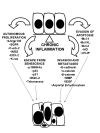Cholangiocarcinoma: modern advances in understanding a deadly old disease
- PMID: 17030071
- PMCID: PMC1686172
- DOI: 10.1016/j.jhep.2006.09.001
Cholangiocarcinoma: modern advances in understanding a deadly old disease
Abstract
Cholangiocarcinomas are tumors that arise anywhere in the biliary tract, presumably of cholangiocyte origin. The global incidence of this rare disease is on the rise. Several known risk factors exist, and link chronic biliary inflammation to the pathogenesis of cholangiocarcinoma. Among these, amplification of the epidermal growth factor receptor, the interleukin-6 signaling pathway, inducible nitric oxide, erb-2, and cyclooxygenase-2 are well defined. Most patients present late, with a median survival of months. Although, imaging studies and clinical context often indicate cholangiocarcinoma, pathologic and cytologic diagnosis is difficult to obtain. Advanced cytologic tests with fluorescence in situ hybridization or digital image analysis can increase diagnostic sensitivity. Surgical resection is the current therapy of choice for both intrahepatic and ductal cholangiocarcinomas. However, the 5-year survival is poor, with 60 to greater than 90% recurrence rates. In a single center experience, liver transplantation with neoadjuvant chemoirradiation, for highly selected patients, has a 5-year disease free survival of greater than 80%. Future targeted therapies will depend on a better understanding of the cellular and molecular biology of cholangiocarcinomas.
Figures








References
-
- Shaib Y, El-Serag HB. The epidemiology of cholangiocarcinoma. Semin Liver Dis. 2004;24:115–125. - PubMed
-
- Patel T. Increasing incidence and mortality of primary intrahepatic cholangiocarcinoma in the United States. Hepatology. 2001;33:1353–1357. - PubMed
-
- Klatskin G. Adenocarcinoma of the Hepatic Duct at Its Bifurcation within the Porta Hepatis. An Unusual Tumor with Distinctive Clinical and Pathological Features. Am J Med. 1965;38:241–256. - PubMed
-
- Chapman RW. Risk factors for biliary tract carcinogenesis. Ann Oncol. 1999;10(Suppl 4):308–311. - PubMed
Publication types
MeSH terms
Grants and funding
LinkOut - more resources
Full Text Sources
Other Literature Sources
Medical
Research Materials

